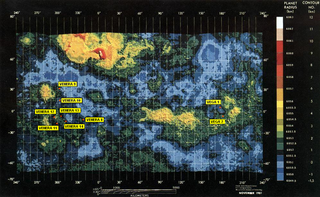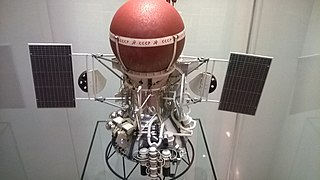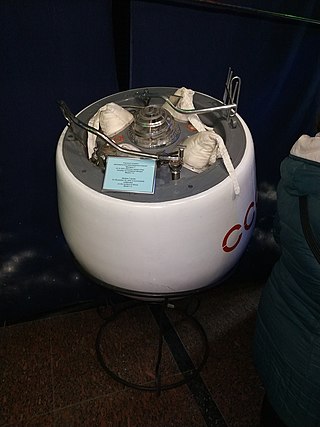
Mariner 5 was a spacecraft of the Mariner program that carried a complement of experiments to probe Venus' atmosphere by radio occultation, measure the hydrogen Lyman-alpha spectrum, and sample the solar particles and magnetic field fluctuations above the planet. Its goals were to measure interplanetary and Venusian magnetic fields, charged particles, plasma, radio refractivity and UV emissions of the Venusian atmosphere.

The Venera program was the name given to a series of space probes developed by the Soviet Union between 1961 and 1984 to gather information about the planet Venus. Ten probes successfully landed on the surface of the planet, including the two Vega program and Venera-Halley probes, while thirteen probes successfully entered the Venusian atmosphere. Due to the extreme surface conditions on Venus, the probes could only survive for a short period on the surface, with times ranging from 23 minutes to two hours.

Luna 1, also known as Mechta, E-1 No.4 and First Lunar Rover, was the first spacecraft to reach the vicinity of Earth's Moon, and the first spacecraft to be placed in heliocentric orbit. Intended as an impactor, Luna 1 was launched as part of the Soviet Luna programme in 1959.
Kosmos 27, also known as Zond 3MV-1 No.3 was a space mission intended as a Venus impact probe. The spacecraft was launched by a Molniya 8K78 carrier rocket from Baikonur. The Blok L stage and probe reached Earth orbit successfully, but the attitude control system failed to operate.

Zond 3 was a 1965 space probe which performed a flyby of the Moon's far side, taking a number of quality photographs for its time. It was a member of the Soviet Zond program while also being part of the Mars 3MV project. It was unrelated to Zond spacecraft designed for manned circumlunar missions. It is believed that Zond 3 was initially designed as a companion spacecraft to Zond 2 to be launched to Mars during the 1964 launch window. The opportunity to launch was missed, and the spacecraft was launched on a Mars-crossing trajectory as a spacecraft test, even though Mars was no longer attainable.

Venera 3 was a Venera program space probe that was built and launched by the Soviet Union to explore the surface of Venus. It was launched on 16 November 1965 at 04:19 UTC from Baikonur, Kazakhstan, USSR. The probe comprised an entry probe, designed to enter the Venus atmosphere and parachute to the surface, and a carrier/flyby spacecraft, which carried the entry probe to Venus and also served as a communications relay for the entry probe.

Phobos 1 was an uncrewed Soviet space probe of the Phobos Program launched from the Baikonour launch facility on 7 July 1988. Its intended mission was to explore Mars and its moons Phobos and Deimos. The mission failed on 2 September 1988 when a computer malfunction caused the end-of-mission order to be transmitted to the spacecraft. At the time of launch it was the heaviest interplanetary spacecraft ever launched, weighing 6200 kg.

The Venera 11 was a Soviet uncrewed space mission which was part of the Venera program to explore the planet Venus. Venera 11 was launched on 9 September 1978 at 03:25:39 UTC.

The Venera 12 was an uncrewed Soviet space mission designed to explore the planet Venus. Venera 12 was launched on 14 September 1978 at 02:25:13 UTC.

Venera 10, or 4V-1 No. 661, was a Soviet uncrewed space mission to Venus. It consisted of an orbiter and a lander. It was launched on June 14, 1975, 03:00:31 UTC and had a mass of 5033 kg (11096 lb).

Zond 1 was a spacecraft of the Soviet Zond program. It was the second Soviet research spacecraft to reach Venus, although communications had failed by that time. It carried a 90-centimetre (35 in) spherical landing capsule, containing experiments for chemical analysis of the atmosphere, gamma-ray measurements of surface rocks, a photometer, temperature and pressure gauges, and a motion/rocking sensor in case it landed in water.

Venera 7 was a Soviet spacecraft, part of the Venera series of probes to Venus. When it landed on the Venusian surface on 15 December 1970, it became the first spacecraft to soft land on another planet and the first to transmit data from there back to Earth.

Venera 2, also known as 3MV-4 No.4 was a Soviet spacecraft intended to explore Venus. A 3MV-4 spacecraft launched as part of the Venera programme, it failed to return data after flying past Venus.

Venera 8 was a probe in the Soviet Venera program for the exploration of Venus and was the second robotic space probe to conduct a successful landing on the surface of Venus.

Venera 14 was a probe in the Soviet Venera program for the exploration of Venus.

The 3MV planetary probe is a designation for a common design used by early Soviet unmanned probes to Mars and Venus. It was an incremental improvement of earlier 2MV probes and was used for Zond 1, Zond 2 and Zond 3 missions to Mars as well as several Venera probes. It was standard practice of the Soviet space program to use standardized components as much as possible. All probes shared the same general characteristics and differed usually in equipment necessary for specific missions. Each probe also incorporated improvements based on experience with earlier missions.
The Soviet Deep Space Network was a network of large antennas and communication facilities that supports interplanetary spacecraft missions, and radio and radar astronomy observations for the exploration of the Solar System and the universe during Soviet times. It was built to support the space missions of the Soviet Union. Similar networks are run by the USA, China, Europe, Japan, and India.
Kosmos 96, or 3MV-4 No.6, was a Soviet spacecraft intended to explore Venus. A 3MV-4 spacecraft launched as part of the Venera programme, Kosmos 96 was to have made a flyby of Venus, however, due to a launch failure, it did not depart low Earth orbit. Its re-entry into Earth's atmosphere is often speculated as the cause of the Kecksburg UFO incident.
Kosmos 167, or 4V-1 No.311, was a 1967 Soviet spacecraft intended to explore Venus. A spacecraft launched as part of the Venera programme, Kosmos 167 was intended to land on Venus but never departed low Earth orbit due to a launch failure.

The KDU-414, is a pressure-fed liquid rocket Propulsion Unit developed and produced by the Isayev Design Bureau. From 1960 onward, it powered several unmanned Soviet Spacecraft, including the first series of Molniya satellites, several Kosmos satellites as well as the space probes Mars 1, Venera 1, Zond 2 and Zond 3, featured as a part of standardized spacecraft buses known as KAUR-2, 2MV and 3MV.











